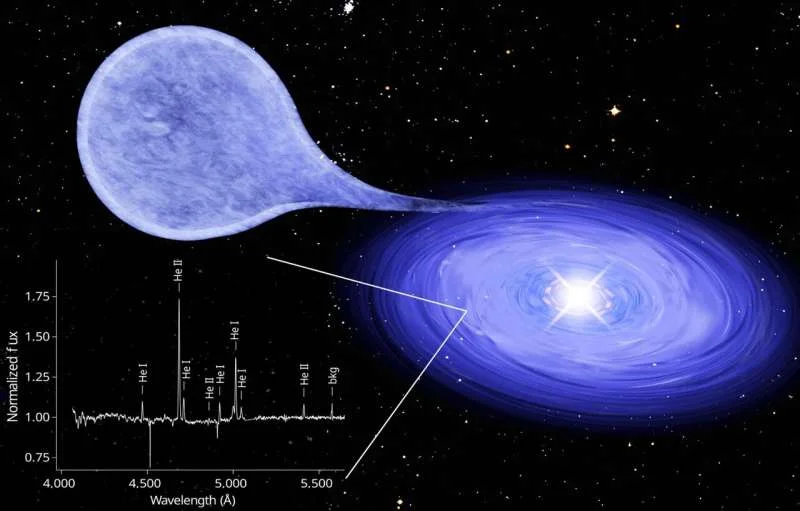Astronomers discover a helium-burning white dwarf
- March 24, 2023
- 0
A white dwarf star can explode as a supernova when its mass exceeds the limit of about 1.4 solar masses. A team led by the Max Planck Institute
A white dwarf star can explode as a supernova when its mass exceeds the limit of about 1.4 solar masses. A team led by the Max Planck Institute

A white dwarf star can explode as a supernova when its mass exceeds the limit of about 1.4 solar masses. A team led by the Max Planck Institute for Extraterrestrial Physics (MPE) in Garching and including the University of Bonn has found a binary star system in which matter is flowing from its companion to a white dwarf.
The system was discovered thanks to the bright, so-called ultra-soft X-ray emission that occurs as a result of nuclear fusion of gas overflowing near the surface of the white dwarf. The unusualness of this source is the overflow and combustion of helium, not hydrogen. The measured luminosity shows that the mass of the white dwarf is increasing more slowly than previously thought, which could help to understand the number of supernovae caused by exploding white dwarfs. The results were published in the journal Nature.
Exploding white dwarfs are not only believed to be the main source of iron in the universe, they are also an important tool for cosmology. So-called Type Ia supernovae (SN Ia) become roughly equally bright, allowing astrophysicists to pinpoint the distance to their host galaxies.
However, even after years of intense research, it remains unclear under what conditions a white dwarf’s mass can grow up to the so-called Chandrasekhar limit. This is the theoretical upper limit of the mass of a white dwarf, determined in 1930 by the Indian-American astrophysicist and Nobel laureate Subrahmanyan Chandrasekhar.
In the early 1990s, ultra-soft X-ray sources with stable hydrogen combustion on their surfaces were established as a new class of objects from ROSAT and were for some time considered potential candidates for SN Ia progenitors. The problem with these sources, however, is an excess of hydrogen: type Ia supernovae show no trace of hydrogen.
Binary star systems where a white dwarf merges and constantly burns helium on its surface have been predicted for more than 30 years, but such sources have never been observed. An international team led by the Max Planck Institute for Extraterrestrial Physics (MPE) has found a source of X-ray radiation whose optical spectrum is dominated entirely by helium.
“A super soft source of X-ray radiation [HP99] 159 has been known since the 1990s, when it was first observed with ROSAT, more recently with XMM-Newton, and now with eROSITA,” explains Jochen Greiner, who analyzed this source at MPE. “It is now an optical source in the Large Magellanic Cloud. We could define it as In its spectrum, we found helium emission lines mainly originating from the accretion disk.”
But that won’t solve the SN Ia ancestral problem: theoretical models predict that about 2-5% of the helium companion star’s matter will be removed by the SN Ia explosion and ejected into the environment. However, this amount of helium has not been found in most Ia supernovae observed to date. However, there is a lower luminosity subclass, SN Iax, where the explosion is weaker and therefore less helium is blown away.
The system is now detected [HP99] According to current knowledge, 159 could terminate at such SN Iax, as measurements show that sustained helium combustion in white dwarfs is possible even at lower than theoretically predicted deposition rates. Measured brightness [HP99] 159 is about ten times smaller than expected at standard speed, while the measured X-ray temperature is well within the expected range for stable helium combustion.
Professor Dr. Argelander Institute of Astronomy. “The observed X-ray luminosity indicates that the combustion of helium entering the white dwarf is offset by its rapid spin, making the eventual explosion of the supernova system likely,” says Norbert Langer. Member of the Interdisciplinary Research Subject department at the University of Bonn.
A wide range of deposition rates leading to eruptions should be possible, as previous measurements have shown that the brightness remains constant for about 50 years.
“Stars without hydrogen shells, such as the companion star found in stars. [HP99] 159 is an important intermediate step in the life cycle of binary stars, which should occur in about 30% of such systems. “There should be many such stars, but only a few have been observed so far.”
The team now hopes to find dozens of similar resources in two Magellanic Clouds using eROSITA. This should allow them to further restrict conditions for SN Ia progenitors.
Source: Port Altele
As an experienced journalist and author, Mary has been reporting on the latest news and trends for over 5 years. With a passion for uncovering the stories behind the headlines, Mary has earned a reputation as a trusted voice in the world of journalism. Her writing style is insightful, engaging and thought-provoking, as she takes a deep dive into the most pressing issues of our time.